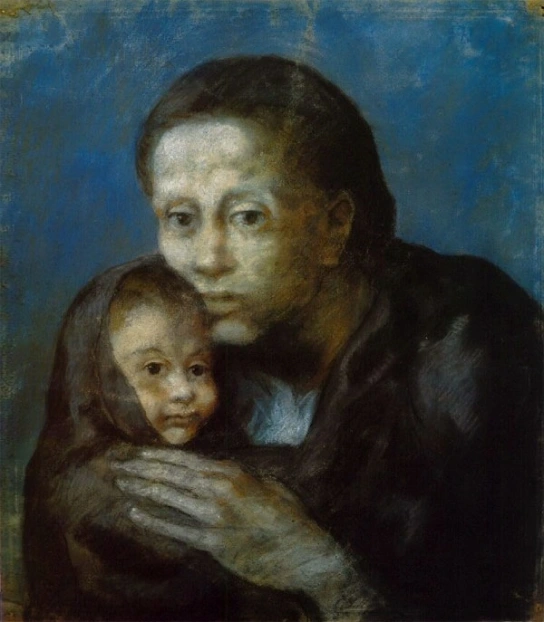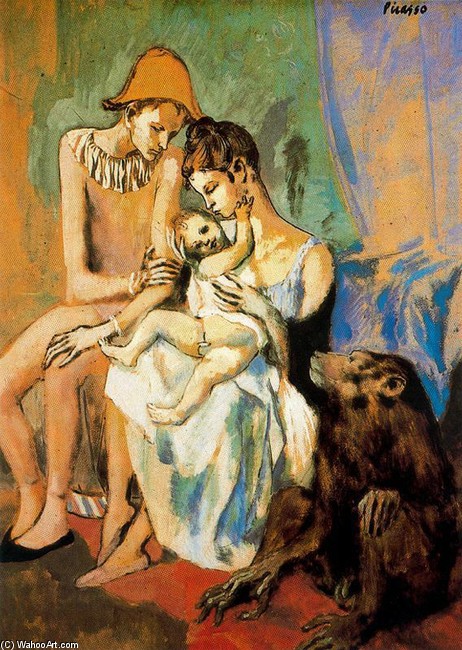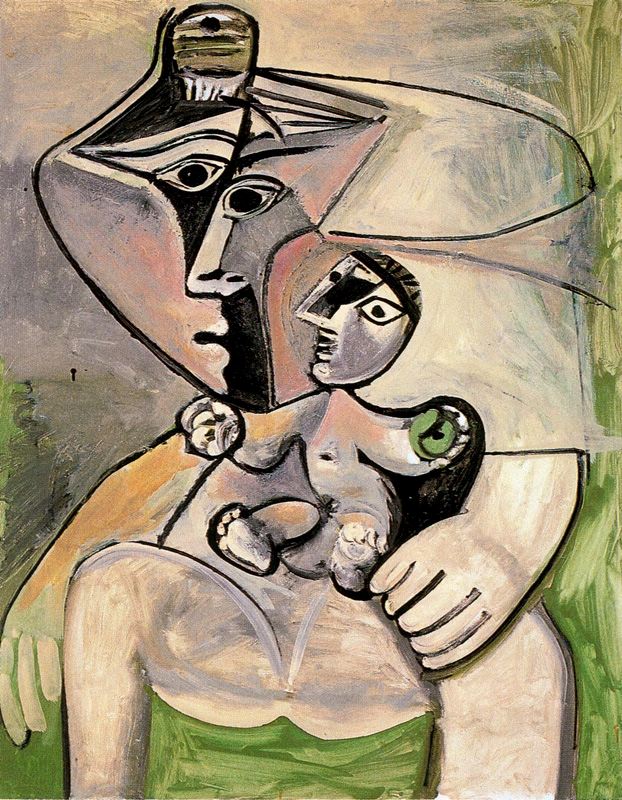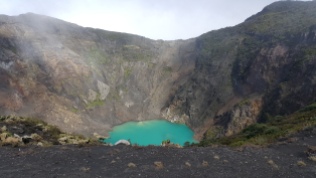A few weeks ago, students in my Hispanic Women’s Literature course turned in their first paper on Carmen de Burgos’ La rampa. Part of their assignment was to include an image with their essay. One student selected the following painting, a 1905 portrait by Picasso:
Since I was not familiar with the context of this particular painting, despite the fact that my research on women’s literary representations of motherhood and maternity in early 20th century Spain is related both historically and thematically, I decided to do a bit of investigating. As I began searching for information, I discovered that Picasso had in fact created numerous paintings entitled “Maternidad” – a quick Google-image search was all I needed! In addition to various renditions of “Maternidad” (Maternity or Motherhood, in English), Picasso also created a number of paintings that depict mothers with their children, several of which are titled “Madre e hijo” (Mother and Child). While I had seen many of these before, I had not considered how they might relate to my research on early 20th century Spanish literature, and I now find myself more closely examining Picasso’s appropriation and depiction of maternal themes. I had already studied the mother-child relationship that appears in, and is in fact thematically central to, one of his most famous pieces, Guernica, created just after the onset of the Spanish Civil War. Unlike some of his more classic and tender renditions of maternity, the mother-child relationship in Guernica is fraught with agony, suffering, and death. It thus serves not merely to demonstrate, but to amplify and critique the extreme horrors and senselessness that war brings to an innocent populace:
This maternal representation in Guernica is the result of numerous studies, and some art historians have interpreted the mother figure metaphorically as representative of certain political and national powers in times of war. The stylistic discrepancy between Picasso’s 1905 and 1937 portrayal of maternal devotion is fascinating from both personal and historical perspectives. Yet a contrast between these two samples alone does not adequately characterize Picasso’s treatment of maternal themes in the early 20th century, and in fact runs contrary to the more general trajectory identified by some scholars. Below are some examples of the treatment of maternity and motherhood in Picasso’s oeuvre. This is by no means a comprehensive analysis, but rather a “springboard” of sorts from which I have just begun to investigate the possible parallels between the literary themes I study and their appearance in contemporary artwork.
In his 2005 article – “La representación de lo materno en Pablo Picasso y Soledad Puértolas” – Pablo Pintado-Casas argues that Picasso’s treatment of maternal themes in his paintings is marked by a strong autobiographical impulse that singularly affects the manner of representation. That is, earlier paintings depict a mother figure that reflects sadness, melancholy, and poverty, similar to the other subjects that appear in his “Blue Period” (Época o periodo azul), 1900-1904 (p. 112). Such portrayals also hark back to Emile Zola and Naturalist impulses of the late nineteenth century. In the Blue Period, maternity and motherhood are in fact frequent subjects, and the life-giving mother figure is paradoxically placed in a dark, blue-gray context that evokes death, illness, and suffering. The accessible introductory text, Essential Picasso, identifies Picasso’s series of “Madonnas” during this time as a prime example of his penchant for combining themes of religion and poverty: “The almost monochromatic use of blue in this period, and its traditional association with the Madonna, are superbly combined to produce a set of haunting, almost ghostly images” (p. 26). Below are a few samples:

“Maternidad” (Mother and Child), Picasso, 1901.

“Maternidad, madre e hijo” (Maternity, mother and child), Picasso, 1903. Image via Wikipedia

“Madre e hijo” (Mother and child), Picasso, 1905.
After seeing these variations on the maternal experience, I think they would serve as evocative complements to Carmen de Burgos’ La rampa in one of my future literature courses, as the novel deals extensively with the harsh realities of maternity for a poor, working-class woman in urban Madrid. Returning to Picasso, this dark “Blue Period” was immediately followed by the “Rose Period” (Época o periodo rosa) from 1904-1906, during which time the artist completed the painting that I included at the top of this post (“Maternidad,” 1905). The Rose period is marked by brighter shades of orange and pink, as well as by subtle lines of expressionism. Picasso’s tendency to render marginalized individuals or social outcasts as worthy artistic subjects is evident by the ubiquitous appearances of circus performers, individuals who were dedicated to their art (performance), yet were frequently mocked by society. The first image of this post, the image my student chose for her paper, was produced during the Rose Period. Below are a few more examples of mothers and their children in this aesthetic:

“Madre e hijo saltimbanquis” (Mother and Child Acrobats), Picasso, 1905.

“Familia de acróbats con mono” (Family of acrobats with monkey), Picasso, 1905. Image via WahooArt.
Returning to the aforementioned article, Pintado-Casas points to 1919-1921 as years that mark a transition in the trajectory of maternal themes in Picasso’s work. He attributes this shift not only to the fact that Picasso traveled throughout Italy and Greece studying neoclassicism and the Italian Renaissance, but that he also became a father (p. 111). The experience of fatherhood especially prompted him to contemplate and approach maternity and motherhood from a new vantage point (p. 113). Picasso’s later depictions of mothers and children reveal a more intimate perspective that admires and glorifies maternity and motherhood. The Art Institute of Chicago agrees with Pintado-Casas’ observations, and also notes that, unlike those frail and anguished figures of the Blue Period, these classical-period figures are “majestic in proportion and feeling“. Picasso produced at least 12 works on the Mother-Child subject between 1921-23:

“Madre e hijo al borde del mar” (Mother and Child on the Seashore), Picasso, 1921. [Art Institute of Chicago]. Image via 20minutos.

“Madre e hijo” (Mother and Child), Picasso, 1921. Image via Artnet

“Mother and Child”, Picasso (1922)
While the Pintado-Casas’ article and the observations of The Chicago Art Institute provide neatly organized, easily-identifiable categories, there are in fact several works that do not quite fit within these timelines. Here are a few more samples of Picasso’s paintings on “Maternidad” that defy, to some extent, that useful, but perhaps over-simplified, trajectory of the evolution of this theme his work.

“Maternity en el campo” (Mother and Child in the countryside), Picasso, 1901.
As part of the early 1900s’ Blue Period, the above painting evokes the imagery of the “Madonna and Child” with the darker, blue and gray hues and the rural landscape. Yet the contrasting colors of the bucolic background – complete with greens, oranges, and pinks – gives the painting a brighter overall appearance. This bright contrast distances the piece from the melancholic, pessimistic depictions of poverty prevalent in the Blue Period (1900-04) and approaches the lighter tones and optimism expressed in the later Rose Period (1904-06). Below are a few examples of later, more abstract mid- and late-20th century models:

“Maternidad”, Picasso, 1963. Image via Tlaxcala.org

“Maternidad con manzana” (Motherhood with apple), Picasso, 1971. Image via Necesitodetodos.org
What are your favorite pieces of art depicting motherhood, maternity, and/or mothers and their children? What other versions of Picasso’s numerous takes on the subject do you prefer?
Resources and works cited:
Payne, Laura. Essential Picasso. Introduction by Dr. Julia Kelly. Bath, UK: Dempsey Parr; Parragon, 2000.
Pintado-Casas, Pablo. “La representación de lo materno en Pablo Picasso y Soledad Puértolas.” Letras Femeninas 31.1 (2005): 107-115. [JSTOR: http://www.jstor.org/stable/23021520].
Wischnitzer, Rachel. “Picasso’s ‘Guernica’. A Matter of Metaphor.” Artibus et Historiae 6.12 (1985): 153-72.
[JSTOR: http://www.jstor.org/stable/1483241].

















I really like Picasso, but I’ve never seen some of these. Very cool.
Thanks for commenting, Kim! I was excited to find them, too; i hadn’t really ever searched for one particular theme in his paintings, so I was pretty intrigued with how many different versions there were on this topic, since i’ve been researching it so much lately! 🙂
Pingback: Picasso’s “Guernica” and Aleixandre’s “Oda”: The Spanish Civil War in Art and Poetry | Rebecca M. Bender, PhD
Pingback: 3 Pieces…3 Masters… ALL Babies! – Conception Inception
Pingback: Women and the Avant-garde: Maruja Mallo’s “Verbenas” (Carnivals) | Rebecca M. Bender, PhD
Do you know where the original is of “Maternidad”, Picasso (1905) at the top of the page? I would be in heaven to see this in person.
Pingback: Exploring Female Identities in Carmen de Burgos’ “La rampa” | Rebecca M. Bender, PhD
Pingback: Dlaczego mamy karmią piersią? - Agnieszka Sawicka